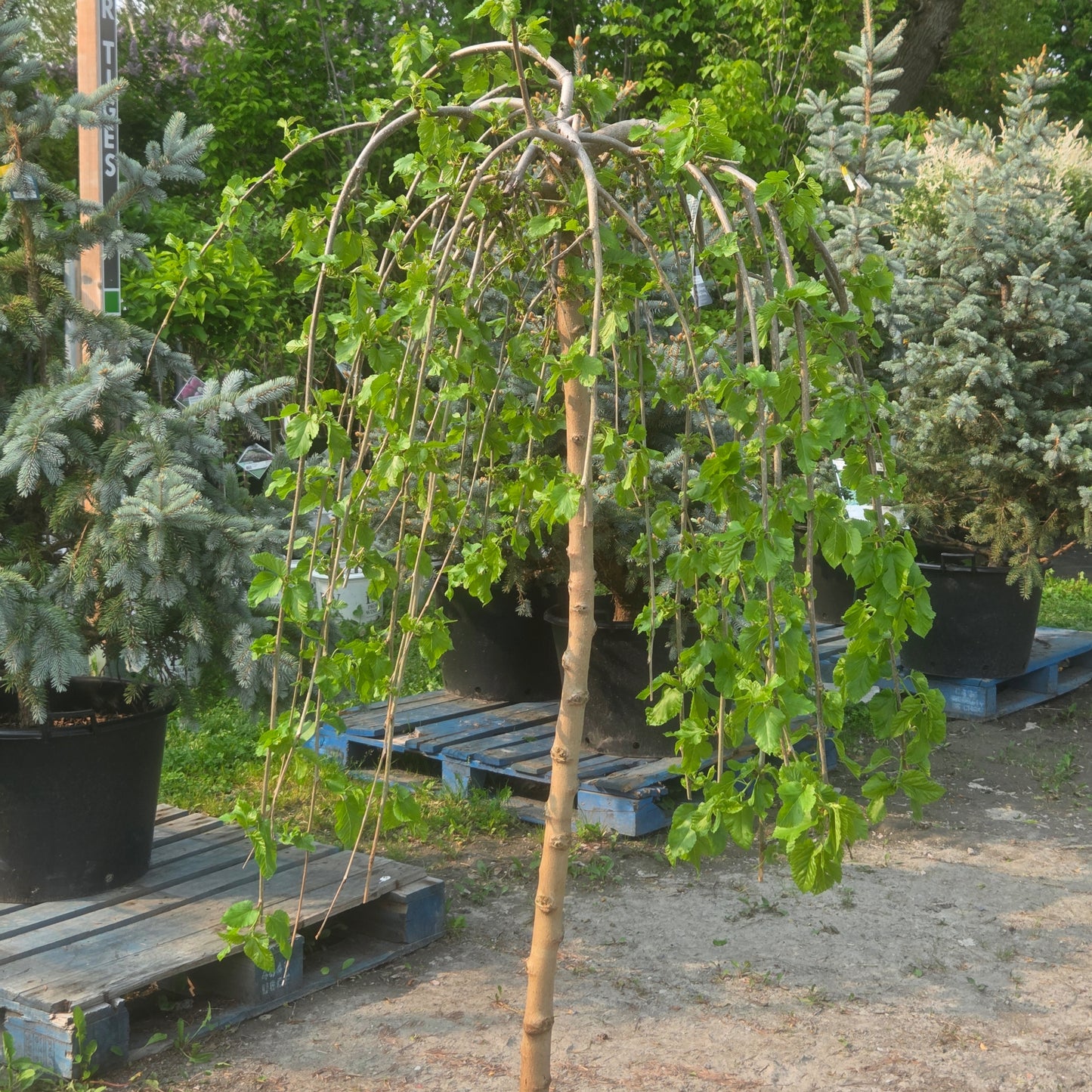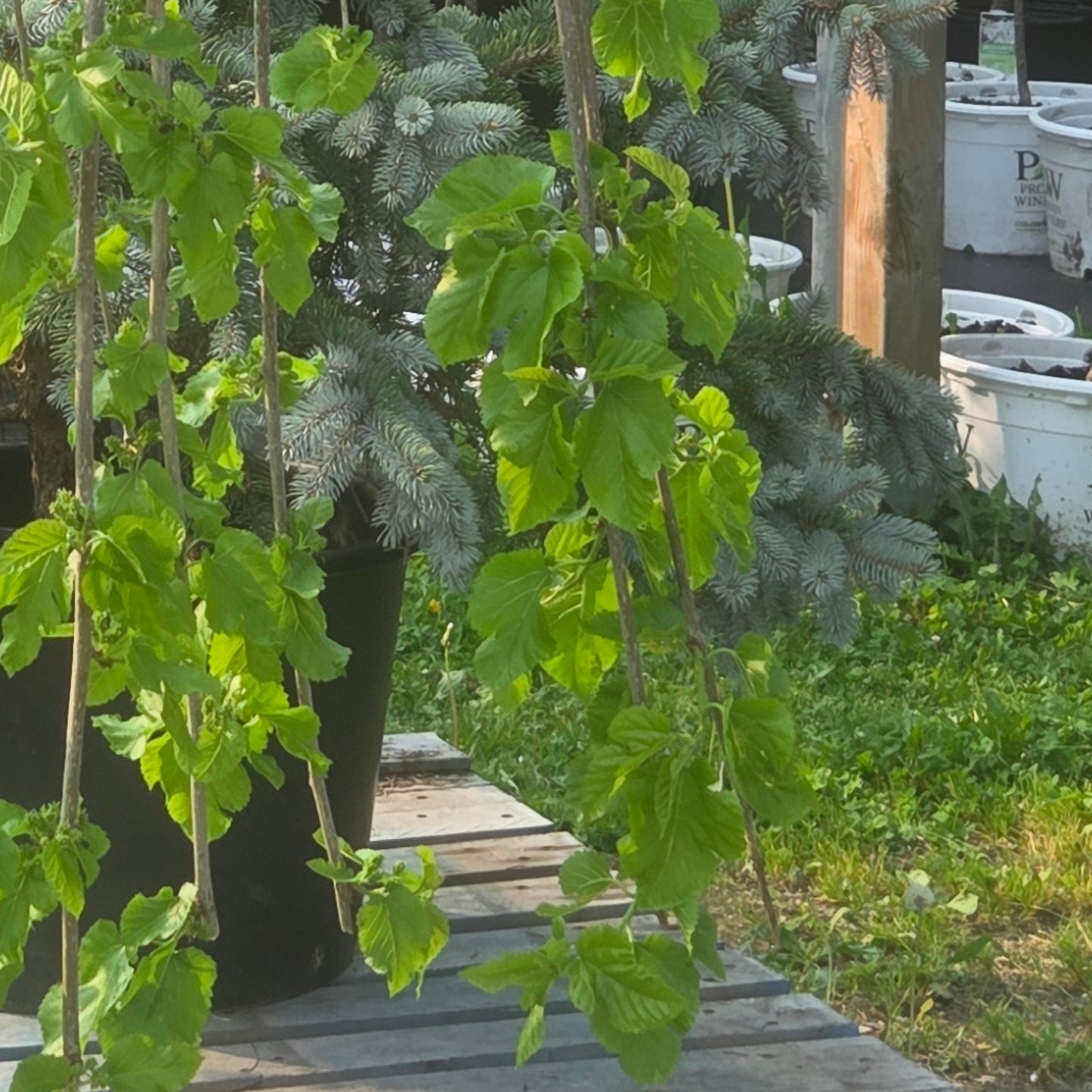1
/
of
4
Morus alba 'Pendula'
Morus alba 'Pendula' - Weeping White Mulberry
Morus alba 'Pendula' - Weeping White Mulberry
Exposure
- Sun
- Partial shade
Rusticity
4, 5, 6, 7, 8, 9
Bloom time
- March
- April
- Unique weeping habit
- Edible white fruit
- Attracts birds
- Fast growing
- Tolerates various soils
Create a dramatic and elegant focal point in your garden with the Weeping White Mulberry (Morus alba 'Pendula')! This unique deciduous tree is renowned for its distinctive umbrella shape and gracefully pendulous branches that reach the ground. Beyond its ornamental appeal, it offers edible white fruits in summer, transforming your outdoor space into a picturesque and lively landscape.
Characteristics
- Foliage: Large, green, often lobed (sometimes unlobed), glossy leaves, up to 20 cm (8 inches) long. They provide an attractive texture during summer. Fall colour is an unattractive yellow, sometimes mixed with green and brown. Foliage is deciduous (falls in winter).
- Flowering: Produces small yellowish-green flowers in drooping catkins in spring (March-April). The primary ornamental interest of this tree lies in its habit and fruit.
- Light Requirements: Best in full sun (6+ hours per day). Can tolerate part shade, but growth and fruiting will be optimal in full sun.
- Habit: Characterized by a distinctive weeping habit, its flexible, arching branches gracefully droop to the ground, creating an umbrella or dome shape.
- Growth: Its growth is rapid. It can quickly reach a height of 1.8 to 3 meters (6 to 10 feet) and a spread of 2.4 to 3.6 meters (8 to 12 feet) at maturity.
- Humidity: Requires medium watering. Prefers moist but well-drained soil. Tolerates moist soils.
- Soil: Adapts to a wide range of soils, including alkaline, sandy, clay, loam, or rocky, provided they are well-drained. Prefers rich, moist soil.
- Temperature: Very hardy. Tolerates heat and drought.
- Watering: Medium watering. Once established, it is drought tolerant, but consistently moist soil is preferred.
- Resistances: Tolerates heat, drought, and air pollution.
Usage
- Types of Use: Excellent as an accent tree or specimen to create a unique focal point in small gardens, near a patio, or a rock garden. Can be used in rain gardens due to its tolerance for wet soils.
- Decorative Benefits: Its distinctive weeping form and fine texture offer an elegant silhouette year-round. In summer, the edible white fruits attract birds, adding animation, though they can be messy when ripe.
Maintenance
- Fertilization: An annual application of compost in spring can promote healthy growth, but is not always necessary in rich soil.
- Pruning: Prune in late fall or early winter to prevent "bleeding" (sap flow). Proper pruning is essential to maintain the desired weeping shape and control the crown size.
- Plantation:
- Spacing: Approximately 2.4 to 3.6 meters (8 to 12 feet) apart to allow its weeping form to develop fully.
- Depth: Plant at the same depth as it was in its container.
- Period: Spring or early fall are the best times for planting.
Plant details
Dimensions
Dimensions
Spacing
- cm
Spread
240 - 360 cm
Height
180 - 300 cm
Spacing
- in.
Spread
94 - 142 in.
Height
71 - 118 in.
Characteristics
Characteristics
Habit:
- Weeping
Flowering colours:
- White
- Green
Plant needs
Plant needs
Watering:
- Tolerates moist soil
- Tolerates dry, well-drained soil
Maintenance:
- Medium
- Autumn pruning
- Spring pruning (before sap flow)
Soil requirement:
Features
Features
Resistance:
- Heat
- Cold
- Drought
- Air Pollution
Attract:
- Birds
Use:
- Accent
- Mass Planting
- Hedge
Attribute:
- Edible (fruits)
- Fast growing
- Everbearing (fruits)












